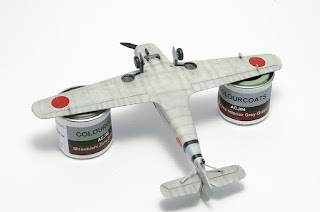Two more Japanese subject 1/72 decal sets from the prolific Rising Decals in their Donated Birds series - III for Houkoku emblazoned Navy aircraft and IV for Aikoku emblazoned Army types. Set Rd72079 (shown above) contains decals for four Mitsubishi A5M4 'Claude' for the Fujimi kit, two Kawanishi E7K1 'Alf' for the Hasegawa kit and two Nakajima B5N1 'Kate' for the Hasegawa or Airfix kits as follows:-
- A5M4 of Chitose Ku - Houkoku # 367 in overall natural metal with red tail at Chitose, Japan from December 1940 to May 1941. This aircraft has a suggested but unconfirmed broad yellow fuselage band.
- A5M4 of Chitose Ku - Houkoku # 373 in overall natural metal with red tail at Chitose, Japan from December 1940 to May 1941. This aircraft has a suggested but unconfirmed broad blue fuselage band.
- A5M4 - Houkoku # 278 in overall natural metal with red tail and white red-bordered fuselage band. This aircraft has the Houkoku legend repeated diagonally across the fin and rudder.
- A5M4 - Houkoku # 278 ditto but with tail code '9-158' at Haikou, Hainan Island, China in January 1940.
- E7K1 - Houkoku # 83 in silver dope with red tail from the light cruiser Kinu (鬼怒) during 1937
- E7K1 - Houkoku # 213 in green and brown camouflage over grey from the heavy cruiser Ashigara (足柄). This aircraft also has the Houkoku legend repeated across the fin and rudder.
- B5N1 - Houkoku # 268 in natural metal with red tail and red bordered white fuselage band. This is the same 12 Ku aircraft which featured in the 1/48 scale set RD48026 reviewed here.
- B5N1 - Houkoku # 268 ditto but in green and brown field applied camouflage retaining red tail during 1939.
A well chosen selection of colourful IJN aircraft with enough plain Hinomaru for one model of each type. The B5N1 options should appeal to builders of the Airfix kit especially as the camouflaged option on that kit's decal sheet is for a 14 Ku example without the red tail.
Set Rd72080 (above) contains decals for two Nakajima Ki-27 'Nate' for the Hasegawa, ICM or RS Models kits, two Mitsubishi Ki-51 'Sonia' for the Hasegawa kit, two Type 91 for the AZ Models kit, and three Nakajima Ki-43 'Oscar' for the Fujimi (or forthcoming Fine Molds), Rising Models and Special Hobby kits as follows:-
- Ki-27 of Akeno Army Flying School - Aikoku # 697 in overall grey-green. This aircraft has a white bordered blue or yellow stripe on the tailfin - both supplied as decal options.
- Ki-27 of Akeno Army Flying School - Aikoku # 645 in overall grey-green. This aircraft has a white cowling front, three white fuselage bands (provided as decals) and a white rudder.
- Ki-51 of 44th Sentai - Aikoku # 569 in a two-tone green camouflage scheme over grey. This aircraft was the subject of the original Hasegawa box art from the 1970s, is well known from a photograph and is an attractive scheme well served by new decals.
- Ki-51 of Hokota Army Flying School - Aikoku # 727 in a green 'snake weave' camouflage over grey. This aircraft has the fuselage Hinomaru on white squares, provided as decals.
- Type 91 of 5th Hiko Rentai - Aikoku # 84 in overal silver dope with twin red stripes on the fin rudder and elevators, provided as decals and red wheel hubs which must be painted.
- Type 91 of 1st Hiko Rentai - Aikoku # 3 in overal silver dope with blue rudder, elevators and wheel hubs all to be painted.
- Ki-43-I of Akeno Army Flying School - Aikoku # 388 in overall natural metal. A rather plain but well known subject which nevertheless displays the beauty of the aircraft to good advantage.
- Ki-43-II possibly of 1st Sentai - Aikoku # 2068 in green mottle over natural metal. This is an early production II with the longer wing of the I, provided for by the Rising Models kit. It is also possible to create this variant by combining the Hasegawa II with Fujimi I wings, requiring a little easy cutting and modification to fit. The presence of the tail stripes, if this is a 1st Sentai aircraft, suggest that the rudder and elevators might be painted in the chutai colour in accordance with their usual practice, possible white or yellow.
- Ki-43-II of 77th Sentai - Aikoku # 3948 in brown and green camouflage over natural metal. This is a late production Nakajima-built aircraft of the variant often referred to as Ki-43-II Kai.
Another set of well chosen and welcome decals for Army fighter types, especially welcome because the small Army Aikoku legends are otherwise difficult to reproduce. The colours and fidelity of printing are very good. Sufficient Hinomaru decals are provided to complete one model of each subject, including one Ki-43-I and one Ki-43-II. Highly recommended to Army aircraft aficionados.
With special thanks to Mirek for providing the review samples.
Image credit: All © 2019 Rising Decals
































